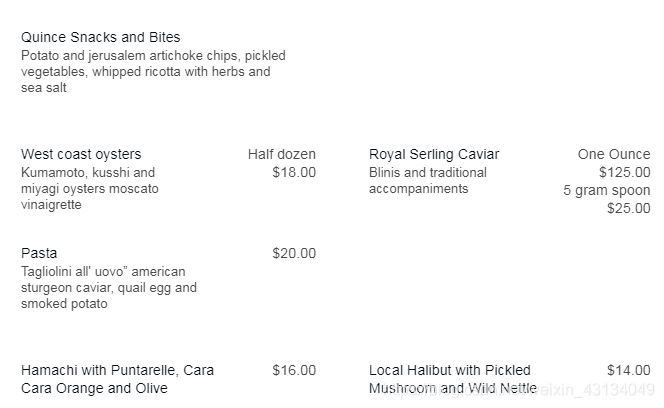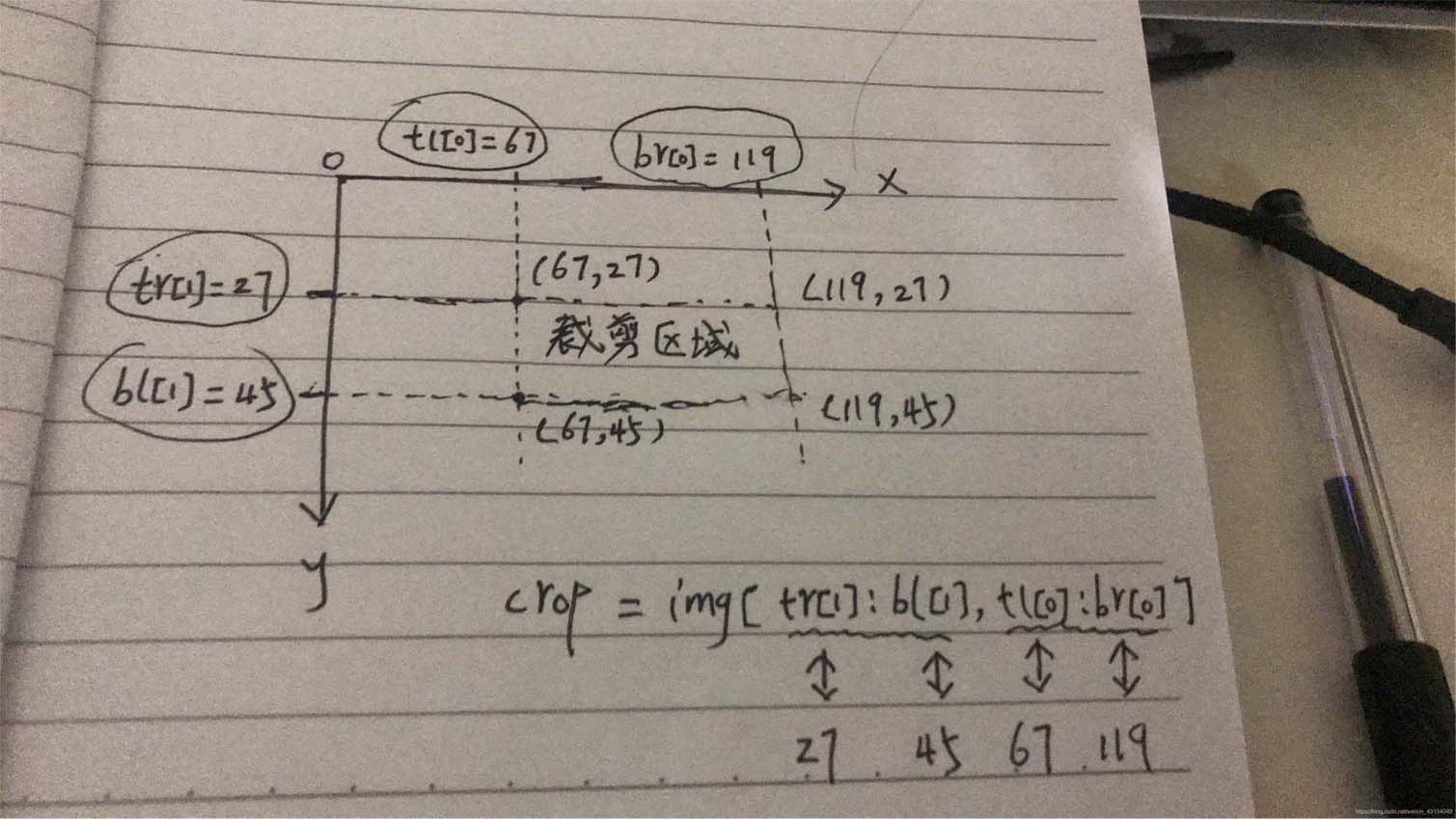您好,登錄后才能下訂單哦!
您好,登錄后才能下訂單哦!
這篇文章主要介紹python中opencv通過4坐標剪裁圖片的示例分析,文中介紹的非常詳細,具有一定的參考價值,感興趣的小伙伴們一定要看完!
本文主要介紹了python opencv通過4坐標剪裁圖片,分享給大家,具體如下:
效果展示,

裁剪出的單詞圖像(如下)







這里程序我是用在paddleOCR里面,通過識別模型將識別出的圖根據程序提供的坐標(即四個頂點的值)進行摳圖的程序(上面的our和and就是扣的圖),并進行了封裝,相同格式的在這個基礎上改就是了
[[[368.0, 380.0], [437.0, 380.0], [437.0, 395.0], [368.0, 395.0]], [[496.0, 376.0], [539.0, 378.0], [538.0, 397.0], [495.0, 395.0]], [[466.0, 379.0], [498.0, 379.0], [498.0, 395.0], [466.0, 395.0]], [[438.0, 379
.0], [466.0, 379.0], [466.0, 395.0], [438.0, 395.0]], ]
從程序得到的數據格式大概長上面的樣子,由多個四個坐標一組的數據(如下)組成,即下面的[368.0, 380.0]為要裁剪圖片左上角坐標,[437.0, 380.0]為要裁剪圖片右上角坐標,[437.0, 395.0]為要裁剪圖片右下角坐標,[368.0, 395.0]為要裁剪圖片左下角坐標.
[[368.0, 380.0], [437.0, 380.0], [437.0, 395.0], [368.0, 395.0]]
而這里剪裁圖片使用的是opencv(由于參數的原因沒有設置角度的話就只能裁剪出平行的矩形,如果需要裁減出不與矩形圖片編譯平行的圖片的話,參考這個博客進行進一步的改進點擊進入)
裁剪部分主要是根據下面這一行代碼進行的,這里要記住(我被這里坑了一下午),
參數 tr[1]:左上角或右上角的縱坐標值
參數bl[1]:左下角或右下角的縱坐標值
參數tl[0]:左上角或左下角的橫坐標值
參數br[0]:右上角或右下角的橫坐標值
crop = img[int(tr[1]):int(bl[1]), int(tl[0]):int(br[0]) ]

總的程序代碼如下
import numpy as np
import cv2
def np_list_int(tb):
tb_2 = tb.tolist() #將np轉換為列表
return tb_2
def shot(img, dt_boxes):#應用于predict_det.py中,通過dt_boxes中獲得的四個坐標點,裁剪出圖像
dt_boxes = np_list_int(dt_boxes)
boxes_len = len(dt_boxes)
num = 0
while 1:
if (num < boxes_len):
box = dt_boxes[num]
tl = box[0]
tr = box[1]
br = box[2]
bl = box[3]
print("打印轉換成功數據num =" + str(num))
print("tl:" + str(tl), "tr:" + str(tr), "br:" + str(br), "bl:" + str(bl))
print(tr[1],bl[1], tl[0],br[0])
crop = img[int(tr[1]):int(bl[1]), int(tl[0]):int(br[0]) ]
# crop = img[27:45, 67:119] #測試
# crop = img[380:395, 368:119]
cv2.imwrite("K:/paddleOCR/PaddleOCR/screenshot/a/" + str(num) + ".jpg", crop)
num = num + 1
else:
break
def shot1(img_path,tl, tr, br, bl,i):
tl = np_list_int(tl)
tr = np_list_int(tr)
br = np_list_int(br)
bl = np_list_int(bl)
print("打印轉換成功數據")
print("tl:"+str(tl),"tr:" + str(tr), "br:" + str(br), "bl:"+ str(bl))
img = cv2.imread(img_path)
crop = img[tr[1]:bl[1], tl[0]:br[0]]
# crop = img[27:45, 67:119]
cv2.imwrite("K:/paddleOCR/PaddleOCR/screenshot/shot/" + str(i) + ".jpg", crop)
# tl1 = np.array([67,27])
# tl2= np.array([119,27])
# tl3 = np.array([119,45])
# tl4 = np.array([67,45])
# shot("K:\paddleOCR\PaddleOCR\screenshot\zong.jpg",tl1, tl2 ,tl3 , tl4 , 0)特別注意對np類型轉換成列表,以及crop = img[tr[1]:bl[1], tl[0]:br[0]]的中參數的位置,
用了兩種方法保存圖片,opencv和Image,實踐證明opencv非常快
from PIL import Image
import os
import cv2
import time
import matplotlib.pyplot as plt
def label2picture(cropImg,framenum,tracker):
pathnew ="E:\\img2\\"
# cv2.imshow("image", cropImg)
# cv2.waitKey(1)
if (os.path.exists(pathnew + tracker)):
cv2.imwrite(pathnew + tracker+'\\'+framenum + '.jpg', cropImg,[int(cv2.IMWRITE_JPEG_QUALITY), 100])
else:
os.makedirs(pathnew + tracker)
cv2.imwrite(pathnew + tracker+'\\'+framenum + '.jpg', cropImg,[int(cv2.IMWRITE_JPEG_QUALITY), 100])
f = open("E:\\hypotheses.txt","r")
lines = f.readlines()
for line in lines:
li = line.split(',')
print(li[0],li[1],li[2],li[3],li[4],li[5])
filename = li[0]+'.jpg'
img = cv2.imread("E:\\DeeCamp\\img1\\" + filename)
crop_img = img[int(li[3][:-3]):(int(li[3][:-3]) + int(li[5][:-3])),
int(li[2][:-3]):(int(li[2][:-3]) + int(li[4][:-3]))]
# print(int(li[2][:-3]),int(li[3][:-3]),int(li[4][:-3]),int(li[5][:-3]))
label2picture(crop_img, li[0], li[1])
# #
# x,y,w,h = 87,158,109,222
# img = cv2.imread("E:\\DeeCamp\\img1\\1606.jpg")
# # print(img.shape)
# crop = img[y:(h+y),x:(w+x)]
# cv2.imshow("image", crop)
# cv2.waitKey(0)
# img = Image.open("E:\\DeeCamp\\img1\\3217.jpg")
#
# cropImg = img.crop((x,y,x+w,y+h))
# cropImg.show()
# img = Image.open("E:\\deep_sort-master\\MOT16\\train\\try1\\img1\\"+filename)
# print(int(li[2][:-3]),(int(li[2][:-3])+int(li[4][:-3])), int(li[3][:-3]),(int(li[3][:-3])+int(li[5][:-3])))
# #裁切圖片
# # cropImg = img.crop(region)
# # cropImg.show()
# framenum ,tracker= li[0],li[1]
# pathnew = 'E:\\DeeCamp\\deecamp項目\\deep_sort-master\\crop_picture\\'
# if (os.path.exists(pathnew + tracker)):
# # 保存裁切后的圖片
# plt.imshow(cropImg)
# plt.savefig(pathnew + tracker+'\\'+framenum + '.jpg')
# else:
# os.makedirs(pathnew + tracker)
# plt.imshow(cropImg)
# plt.savefig(pathnew + tracker+'\\'+framenum + '.jpg')以上是“python中opencv通過4坐標剪裁圖片的示例分析”這篇文章的所有內容,感謝各位的閱讀!希望分享的內容對大家有幫助,更多相關知識,歡迎關注億速云行業資訊頻道!
免責聲明:本站發布的內容(圖片、視頻和文字)以原創、轉載和分享為主,文章觀點不代表本網站立場,如果涉及侵權請聯系站長郵箱:is@yisu.com進行舉報,并提供相關證據,一經查實,將立刻刪除涉嫌侵權內容。